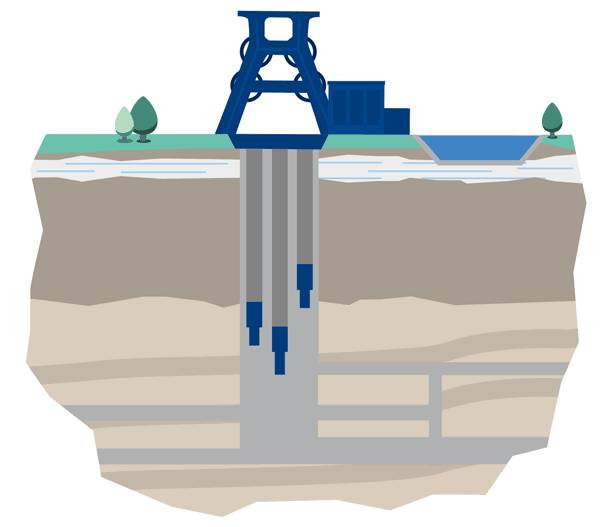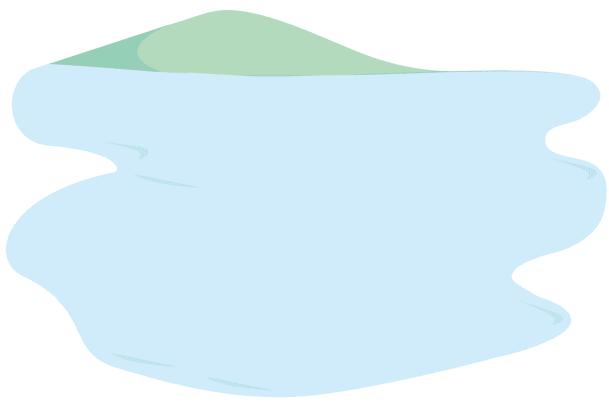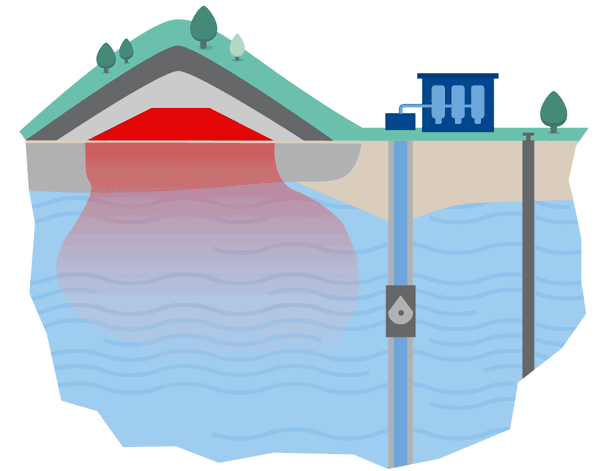Post-mining – what does it involve?

What are the so-called “perpetual tasks”?
These concern the technical engineering activities that occupy us in the wake of coal mining activity in the Ruhr, Saar and Ibbenbüren areas. As they can sometimes endure indefinitely, we can them “perpetual tasks”. These include minewater management, the constant pumping of surface water (empoldering) and groundwater purification at specially designated locations. All of these “perpetual tasks” are focussed on one thing - the resource that is water.
What do we mean by minewater management?
Once regular mining activities have ceased, there is no longer any technical necessity to keep the underground shafts and drifts free of water. So, the water is allowed to rise in a controlled manner. This takes places quite slowly via natural inflows such as groundwater and seepage. To prevent the minewater from coming into contact with higher-lying freshwater strata, the object is to repump it to a certain level. The current minewater management plan for the Ruhr Area stipulates that a 150-metre safety margin be maintained. The Research Center of Post-Mining helps guide these processes, researching the scientific basis for establishing a long-term water management plan.


Why do we have to pump some waterways on the surface, too?
Intensive mining activity has caused the terrain and surface to sink so deeply in places, causing the formation of large depressions – called “polder areas”. In areas such are these, sometimes not all of the waterways can still flow freely. The deeper-lying areas therefore have to be continuously drained to prevent the accumulation of water in rivers and lakes. Every single year, around 800 million cubic metres of water are pumped at more than 600 pumping stations in the Ruhr Area alone.
Why does the groundwater have to be monitored at special sites?
Harmful substances can penetrate into the soil at former industrial areas, especially the places where coking plants were once located. These present a hazard to the environment and to groundwater. So, they have to be specially managed, monitored and, in some cases, cleaned-up over an indefinite period of time.

More FAQs
What exactly is mine water?
Minewater is all water that has or had contact with mining activities located underground or on the surface. It is usually water that naturally occurs in the form of seepage and groundwater. It may share the same quality as the local natural water, or it may contain foreign substances, depending on its origins or previous uses. This means it is particularly important to monitor the quality of the water. But minewater also presents opportunities: its geothermal potential can be used to heat buildings above ground, for example.
What is groundwater?
Groundwater is subterranean water that fills the cavities of the outer more layer of the earth’s crust (the lithosphere). Its movements are determined solely by gravity. Groundwater is formed by rainwater that seeps into the ground, and penetrates through numerous layers of rock, deep down into the earth’s crust. Most of our drinking water is sourced from groundwater. Protecting it from contamination is therefore our highest priority – minewater and groundwater cannot be allowed to come into contact with one another.
So why do we even allow minewater to rise up underground?
Now that coal mining activity has ceased, it is no longer strictly necessary to continuously pump the minewater away. So, it makes sense, both ecologically and economically, to allow it to rise in a controlled manner underground. This takes place through the inflow of groundwater and seepage over long periods of time.
Can there ever be an end to the rise of minewater?
From a technical perspective, the ascent of minewater within an underground minework is over once the water level stops changing. This can occur, for example, when a hydraulic balance is established between the inflow and outflow of the water. The duration and exact progression of the minewater ascent are influenced by a number of factors here, including the characteristics of the rock, and the incoming volumes and flow path.
Would the Ruhr Area really become submerged, if the pumps were switched off?
This completely depends on what pumps are referred to here:
If the underground pumps were switched off, nothing much would happen at the outset. The large cavities of the mines could initially accommodate a large amount of ascending minewater. So much so, that it would take a few decades before the water rose to the surface in the Ruhr Area. However, this is not planned whatever happens: Huge immersion pumps will, in future, continue to keep the minewater at a certain level underground.
On the other hand, if the pumps located in areas of mining subsidence – known as “polders” – were switched off, then waterlogging would occur, with lakes forming relatively quickly. Certainly, large parts of the Ruhr Area would become submerged under water within only hours or a few days.
Why not just stick a lid on and leave it?
That is prohibited by the special responsibility that is owed to the people, nature and the environment living and existing in these former mining districts and beyond. In Germany and Europe, the decommissioning of mines is subject to stringent conditions. However, there is still a lag here internationally. This is another area in which the Research Institute of Post-Mining is engaged, passing on its knowledge in the effort to make the mining of raw materials a more sustainable and environmentally-friendly activity, worldwide.
Will we ever begin mining coal again here?
From a technical perspective, it would be possible. But the costs would be considerable, making it economically non-viable – in the near future, at least.
Sinkhole, uplift & Co.: Do mining damages also rank among the perpetual tasks?
By definition, mining damages are not part of the so-called perpetual tasks. And that's because, in the end, all mining damage is finite. This means that possible subsidence and uplift of the site, which are caused by mining, will be completed at some point.
Why is post-mining a future task?
After a mining process, a new long-term era is dawning: the post-mining era. The consequences of mining will occupy many more generations. A great deal of specialist knowledge is necessary to make the development of former mining regions sustainable. For discovering new potentials in old areas, it is important to understand the challenges as opportunities. Therefor our research is in demand worldwide: Technical innovations can be marketed globally, for example in the areas of monitoring or material science. In addition, we also need well-trained specialists in the future, especially for the long-term technical tasks that mining leaves behind. We educate these experts in our own Master's degree in "Geoengineering and Post-Mining" at the THGA in Bochum. Masterstudiengang „Geoingenieurwesen und Nachbergbau“ an der THGA in Bochum aus.
What's happening with post-mining activities internationally?
Post-mining is becoming increasingly important internationally. Other countries are taking a great interest in the activities ongoing in Germany, and the particular way in which we are managing the legacies of mining – from making sites technically safe, to the subsequent use of these sites as areas of recreation. Germany has a unique opportunity to assume a pioneering role in the post-mining area.
Want to study post-mining?
The THGA's unique “Geo-engineering and Post-mining” master's programme prepares engineers for the post-mining era. And giving them superb career prospects.
Discover more about our master course

